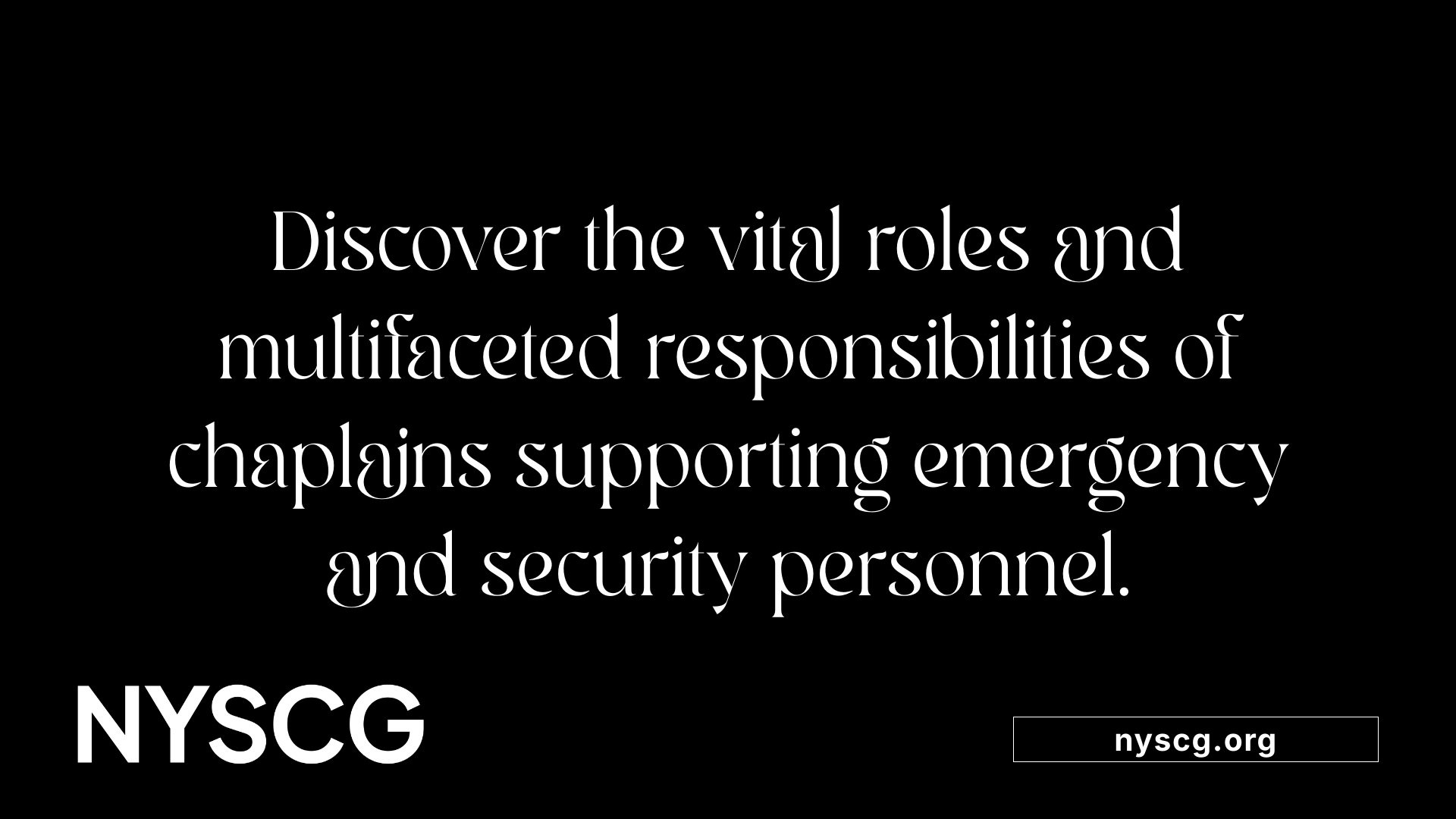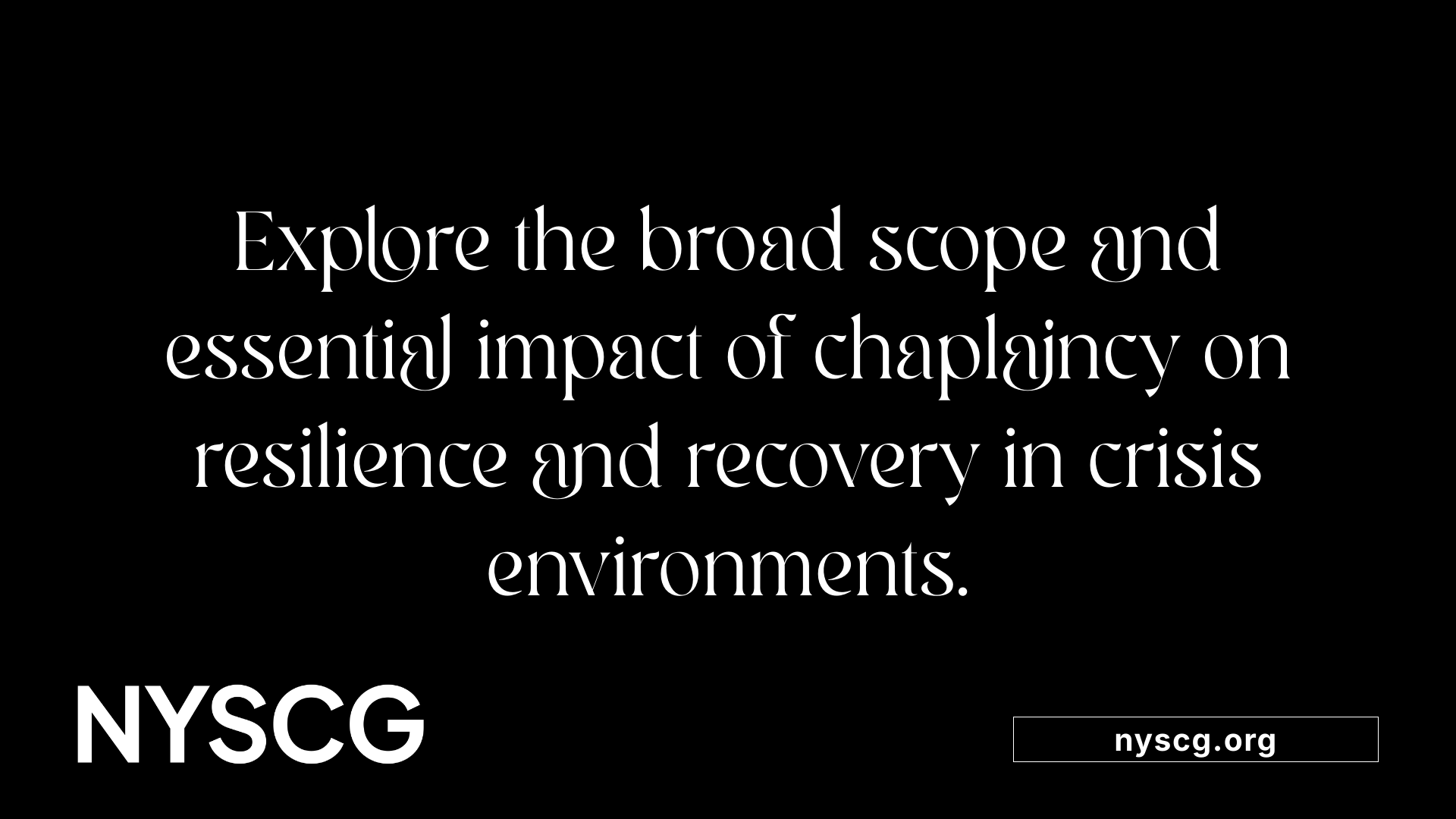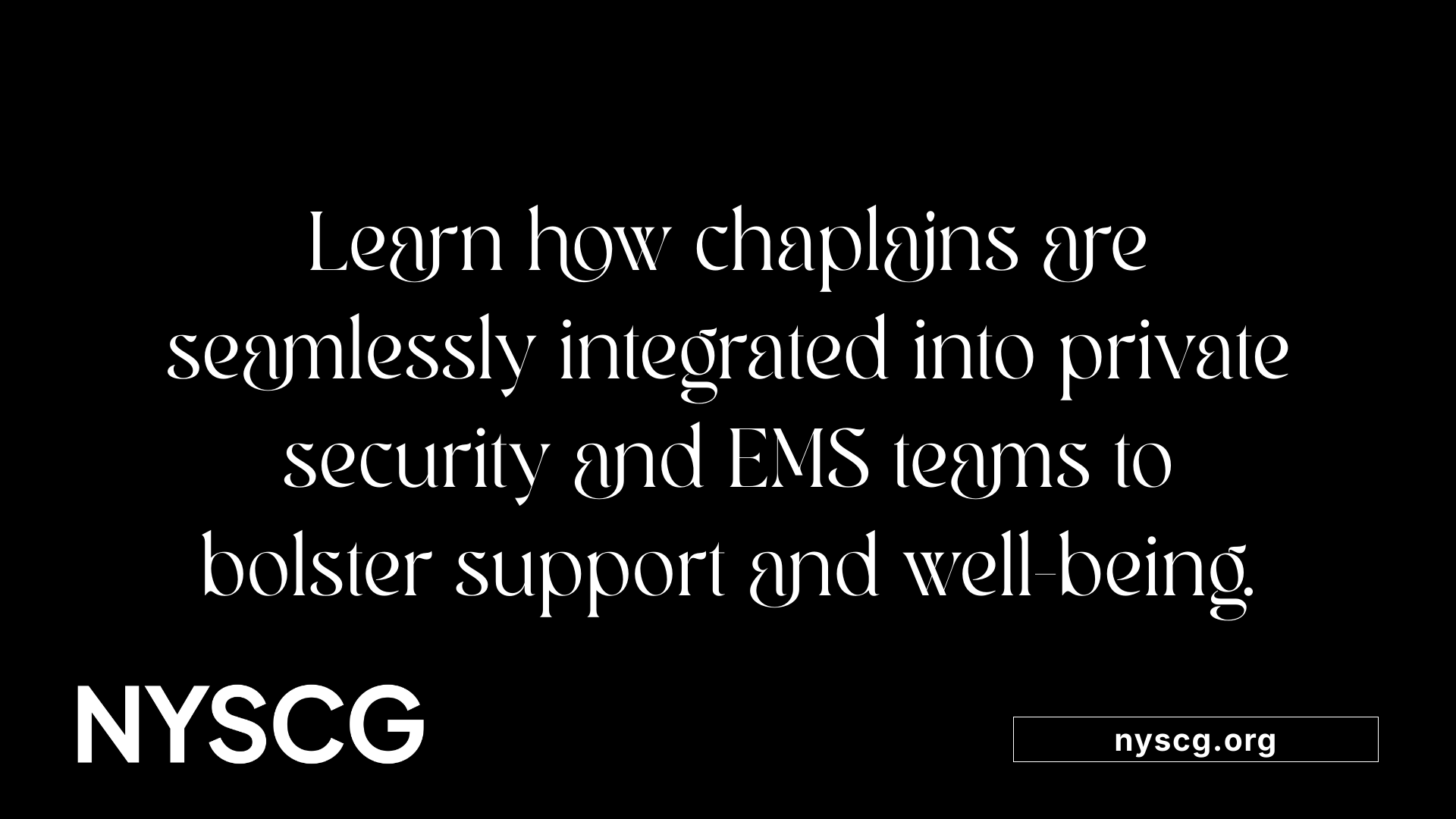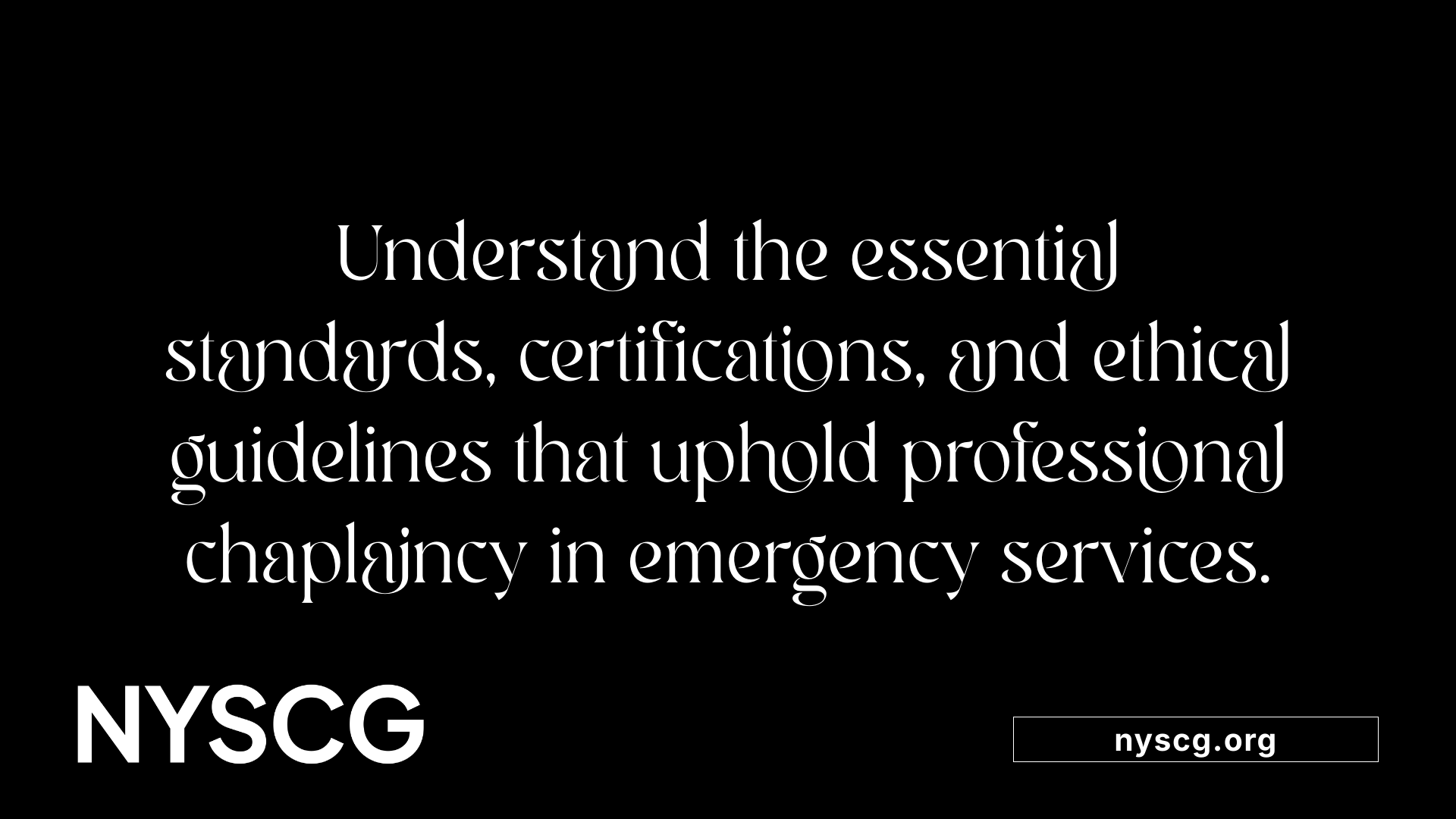Exploring Chaplain Roles in Private Security and EMS Teams


Chaplains play an increasingly vital role in private security and EMS teams by providing emotional, spiritual, and mental health support to personnel. Their presence enhances resilience, morale, and organizational cohesion in environments characterized by trauma, crisis, and high-pressure decision-making. This article explores the multifaceted roles, responsibilities, qualifications, and evolving significance of chaplains, emphasizing their importance in supporting responders during and after critical incidents.

Chaplains play a vital role in supporting emergency response and security personnel by providing spiritual and emotional aid during critical incidents. They serve as compassionate listeners and moral guides, helping staff cope with traumatic situations, such as accidents, natural disasters, or acts of violence.
Their duties include performing religious rites, offering counseling, and facilitating crisis intervention. For example, chaplains might conduct memorial services, help with funeral arrangements, or provide spiritual care tailored to diverse faith backgrounds. They support mental health resilience by addressing stress, grief, and burnout that often impact responders.
Chaplains maintain an active presence—visiting stations, attending incidents, and supporting staff in hospitals or in the field. They prioritize confidential care, ensuring personnel can speak openly without fear of judgment or breach of privacy.
Beyond individual support, chaplains advise leaders on ethical, moral, and cultural issues encountered during crises. They also help develop educational programs aimed at promoting organizational well-being.
Furthermore, their work fosters a positive operational environment. By cultivating trust and demonstrating organizational care for staff, chaplains contribute to a resilient, empathetic culture within emergency and security agencies.
Roles and ResponsibilitiesDescriptionAdditional DetailsEmotional and spiritual supportProviding comfort during emergenciesIncludes prayer, presence, and active listeningReligious rites and ceremoniesPerforming chaplain-led servicesWeddings, memorials, rites of passageCrisis intervention and counselingSupporting staff after traumatic eventsDe-escalating distress, grief supportConfidential guidanceMaintaining privacy and trustCreating safe spaces for staff to express concernsEthical and moral advisingAssisting with complex decision-makingUpholding professional and personal integrityEducational developmentTraining and promoting awarenessResilience, stress management programs
Chaplains serve as a bridge between the organizational mission and the personal spiritual needs of personnel. Their holistic support helps foster a resilient workforce capable of navigating the intense pressures of emergency response and security work.

Chaplaincy in emergency and security sectors encompasses a broad range of support services aimed at responders, victims, and the wider community during crises. These services include emotional reassurance, spiritual guidance, and mental health support, which are crucial for maintaining resilience amid stressful situations.
Chaplains are integrated into organizations through well-defined roles, policies, and procedures. They operate independently of management hierarchies to foster trust and openness, ensuring that responders feel comfortable seeking support without fear of judgment or breach of confidentiality.
Standardized training and ongoing education empower chaplains to deliver their services ethically and effectively. Many are trained in crisis intervention, grief counseling, and spiritual care, often with backgrounds in counseling, social work, or clinical chaplaincy.
The contributions of chaplains significantly impact resilience and team cohesion. By supporting mental health and de-escalating distress during and after traumatic events, they help prevent burnout, reduce turnover, and mitigate risks such as PTSD or suicidal ideation among responders.
Collaboration with agencies like FEMA, Red Cross, and various fire and police departments is vital. These partnerships facilitate the integration of chaplaincy into disaster response plans, allowing for immediate assessments and tailored support services, including wheelchair resources and inpatient care.
Through active participation in disaster drills, community outreach, and crisis response teams, chaplains enhance operational effectiveness.
Their holistic support addresses emotional, spiritual, and psychological needs, fostering recovery, strengthening community trust, and improving the overall capacity of emergency agencies to respond to and recover from crises.
AspectFocusAdditional DetailsResponse SupportEmotional, spiritual, mentalCrisis intervention during incidents, post-incident follow-upOrganizational RolePolicies, proceduresClear role definitions to ensure effectiveness and respect for beliefsTraining & EducationSpecialized trainingClinical background, crisis management, ongoing professional developmentInteragency CollaborationFEMA, Red CrossTiered support, disaster readiness, resource sharingImpactResilience, cohesion, recoveryPrevents burnout, reduces attrition, enhances community trust
In summary, chaplaincy in emergency and security sectors provides an invaluable layer of support that addresses the often-overlooked psychological and spiritual dimensions of crises. Their involvement strengthens responsiveness, promotes healing, and contributes to the overall success of emergency operations.

Chaplains are incorporated into private security and EMS entities through structured programs that outline their roles, responsibilities, and ethical guidelines. These programs ensure that chaplains support staff emotionally, spiritually, and during crises without conflicts of interest.
In most cases, chaplains are assigned to support teams where they provide immediate assistance during traumatic events, such as severe injuries or disasters. Their presence helps create a supportive environment, fostering mental resilience among responders.
Part of their integration involves participating directly in incident responses by riding along with crews, attending to staff at the scene, or supporting families and bystanders. They also engage in debriefing sessions post-incident and offer follow-up care, either through phone calls or face-to-face meetings.
Standard operating procedures (SOPs) and credentialing standards are established to ensure chaplains work professionally and ethically. These standards emphasize confidentiality, non-denominational support, and adherence to safety protocols.
The role of chaplains extends beyond immediate incident response. They work to build organizational trust and resilience by normalizing stress responses, providing ongoing support, and demonstrating that the organization values its staff’s well-being.
This integration creates a culture where mental health support is accessible, reducing barriers to seeking help, and strengthening the overall health ecosystem within private security and EMS agencies.
Chaplains serving in high-stakes settings like emergency services need a strong foundation of both theological and clinical training. They should hold relevant degrees or certification in spiritual care, counseling, or related fields. Certifications in crisis intervention, mental health, and psychological first aid are also essential, allowing them to respond effectively to trauma and acute mental health issues.
Experience is highly valued; typically, a minimum of five years in ministry or related roles is expected to ensure familiarity with emotional and spiritual support practices. Endorsement from a recognized religious body is necessary, along with a clean criminal record confirmed through background checks—integral for maintaining trust and credibility.
Specialized training programs such as completing the 12-week Associate Chaplain curriculum, which includes coursework with FEMA, Critical Incident Stress Management (CISM), and disaster spiritual care, prepare chaplains for unique emergencies like death notifications, active shooter incidents, and large-scale disasters.
Beyond formal qualifications, personal qualities are crucial. Compassion and emotional resilience aid in handling distressing incidents, while strong communication skills facilitate trust and effective support. Professionalism and the ability to operate in a constantly high-pressure environment—often beyond standard working hours—are vital.
Many chaplains serve as volunteers or as department employees, and their role often involves working independently yet collaborating closely with support teams, including mental health professionals. Overall, a blend of comprehensive training, relevant experience, and personal attributes enables chaplains to provide vital support to emergency responders during their most challenging moments.
Chaplains are increasingly sought after within security, law enforcement, and emergency medical services (EMS) because they provide essential emotional and spiritual support tailored to the needs of personnel facing high-stress situations. Their role is vital in fostering resilience and mental well-being among staff who routinely encounter trauma and danger.
One of their primary contributions is helping overcome barriers to seeking help. By offering confidential support, chaplains encourage personnel to open up about their mental health struggles without fear of stigma or professional repercussions. Their presence on-scene during traumatic incidents or follow-up visits to stations normalizes conversations about stress, grief, and burnout.
Effective integration of chaplaincy involves establishing clear protocols and standards. Many agencies employ trained chaplains with diverse backgrounds—clergy, counselors, or professionals with clinical experience—ensuring they can address a broad spectrum of emotional and spiritual needs.
Chaplains support staff through activities like attending critical incidents, providing de-escalation during distressing scenes, and follow-up care. This proactive engagement significantly reduces psychological harm, helps staff process traumatic events, and enhances their overall mental health resilience.
The role of chaplains extends beyond individual support; their visibility and accessibility foster a culture of trust and support within organizations. Their independent yet collaborative presence demonstrates that the organization values its personnel’s mental health, which boosts morale and encourages a positive workplace environment.
Research and real-world reports highlight that organizations with dedicated chaplain programs experience improved staff retention, lower burnout rates, and higher job satisfaction. As the mental health of first responders and security personnel becomes a priority nationally and internationally, the demand for chaplain services continues to grow.
In summary, chaplains serve as vital organizational assets in security and emergency sectors by providing trusted, confidential support that enhances resilience, de-stigmatizes help-seeking, and promotes a healthier, more robust workforce. Their presence helps ensure that those who serve in these demanding roles receive the emotional care necessary to sustain their effectiveness and well-being.
Chaplains play a crucial role in supporting emergency responders during and after traumatic incidents. Their presence offers a sense of spiritual stability, emotional reassurance, and moral guidance at difficult times. As moral and spiritual anchors, they serve as a comforting force, representing the sacred or divine in their support, regardless of personal religious beliefs.
Their active listening and empathetic presence help responders process distressing experiences, find meaning in their work, and regain hope. This holistic support not only alleviates immediate emotional pain but also fosters long-term resilience.
Chaplains are also essential in addressing issues like moral injury and spiritual distress, which can deeply impact mental health. They utilize assessment tools and innovative techniques such as Pastoral Narrative Disclosure, facilitating open dialogue about trauma and moral conflicts.
Their support bridges emotional, spiritual, and psychological needs, promoting healing and recovery. By integrating spiritual care into trauma response, chaplains help emergency personnel cope effectively with the stresses of their demanding work.
Chaplains employ specialized assessment instruments to identify signs of spiritual or emotional distress early. Techniques like Pastoral Narrative Disclosure allow responders to share their trauma stories in a safe space, helping them process feelings and find pathways to healing.
Furthermore, innovative approaches include providing mindfulness, reflection exercises, and peer support facilitation. These methods empower responders to manage stress and develop resilience strategies tailored to their individual needs.
By offering consistent presence and tailored support, chaplains foster a resilient mindset among emergency personnel. Their engagement encourages coping skills, emotional expression, and a sense of community within the team.
Support from chaplains can reduce burnout and prevent the development of more severe mental health issues. They also help responders reconnect with their purpose, reinforcing their commitment and capacity to serve effectively.
Chaplains are trained to support staff from various religious and spiritual backgrounds. Their approach is inclusive, respecting individual beliefs while providing compassionate care. This diversity awareness ensures that support is personalized and meaningful for each responder.
Chaplains' ability to serve a broad range of spiritual traditions and secular perspectives makes them an invaluable resource in modern emergency response teams, facilitating a comprehensive approach to mental health and resilience.
The role of chaplains within emergency and security services has transformed considerably over time. Originally, they primarily provided spiritual and moral support during wartime, focusing on religious rites and faith-based counseling.
Today, chaplains serve as integral members of multidisciplinary teams supporting the mental health and emotional resilience of emergency responders. They offer crisis intervention, psychological first aid, and stress management, helping personnel process traumatic incidents and reduce burnout.
This evolution reflects a shift from solely religious care to a broader, holistic approach to well-being. Chaplains actively engage with staff in their work environments, attending to their emotional needs during and after emergencies. They foster trust and openness by maintaining presence during critical moments and offering support without judgment.
Their activities now include conducting debriefings, providing follow-up care, and organizing mental resilience programs. As a result, chaplaincy has expanded into a vital component of organizational health, helping prevent issues such as PTSD, depression, and suicidal ideation among responders.
This dynamic role continues to adapt to new challenges and environments, emphasizing compassion, mental health awareness, and cultural sensitivity. As services face evolving threats and stresses, chaplains are increasingly equipped with specialized training to meet these needs effectively.
Chaplains work alongside psychologists, peer support officers, medical staff, and management to create a supportive network for emergency personnel. This integration allows for seamless care delivery, ensuring responders receive comprehensive support. They often participate in team meetings, crisis planning, and training sessions to foster organizational resilience.
Beyond traditional support roles, chaplains now provide education on mental health, assist in community outreach, and support families affected by emergencies or crises. They serve in diverse settings like hospitals, prisons, and public safety departments, demonstrating the versatility and importance of their role.
Training programs for chaplains are increasingly including mental health first aid, cultural competency, trauma-informed care, and crisis response techniques. These enhancements prepare chaplains to handle complex emotional situations and diverse community needs.
Anticipated developments include incorporation of digital platforms for remote support, increased collaboration with mental health specialists, and further diversification of chaplaincy services to embrace various faiths and non-faith-based support models. The focus will likely shift toward destigmatizing mental health care and promoting resilience in high-pressure environments.
AspectCurrent PracticeFuture OutlookDetailsRole of ChaplainsSpiritual and emotional supportBroader mental health and resilience focusIncorporating training in trauma and cultural competencyIntegrationMultidisciplinary teamsFully embedded within organizational health initiativesTeam collaboration and shared responsibilitiesServices scopeCrisis support, spiritual careIncluding digital, community, and family supportExpanding beyond immediate respondersTrainingSpecialized certificationAdvanced degrees, interdisciplinary trainingEmphasizing mental health, cultural diversityEmerging TrendsIn-person support, traditional rolesDigital support, destigmatization, holistic careAdapting to societal and technological changes
Continuing evolution in chaplaincy will ensure that emergency and security services are better equipped to support their personnel’s mental, emotional, and spiritual well-being, fostering resilient communities and organizations.

Yes, chaplains serving in security and EMS roles are generally required to meet specific standards and obtain relevant certifications to ensure their effectiveness, professionalism, and preparedness. Many pursue certifications in areas such as clinical pastoral education (CPE), crisis intervention, and mental health support. These credentials enable chaplains to handle complex emotional and psychological scenarios encountered in emergency settings.
In addition to individual certifications, organizational and governmental regulations set clear role responsibilities. For example, in military and organizational contexts, standards like Army Regulation 165–1 specify qualifications, expectations, and readiness components for chaplains. These guidelines help maintain quality and consistency across services.
Operational procedures, such as Standard Operating Procedures (SOPs), also define when and how chaplains are to be engaged during critical incidents. Adherence to these protocols, alongside a commitment to a code of ethics, helps ensure that chaplains act within professional boundaries while providing confidential, respectful support.
Maintaining these standards is essential to uphold the credibility and trustworthiness of chaplaincy services in security, EMS, and other emergency response environments. They support the goal of delivering compassionate, appropriate support that aligns with organizational policies and ethical practices.
As the landscape of security and emergency medical services continues to evolve, the role of chaplains becomes increasingly indispensable. Their ability to provide holistic support—spiritual, emotional, and psychological—bolsters the resilience and effectiveness of personnel facing high-stress and traumatic situations. Standardized training, organizational integration, and ongoing professional development are vital to sustaining and expanding their impact. Moving forward, chaplains will likely play an even more prominent role in fostering organizational culture, enhancing community relations, and addressing the complex mental health needs of responders. Embracing innovation and maintaining high standards will help ensure that chaplaincy continues to serve as a cornerstone of support in emergency and security environments, ultimately saving lives, strengthening responders, and fortifying community trust.
All you need is the will to make the world a better place.
New York State chaplain group inc. is a tax deductible organization with a federal tax Id number 92-383-4921